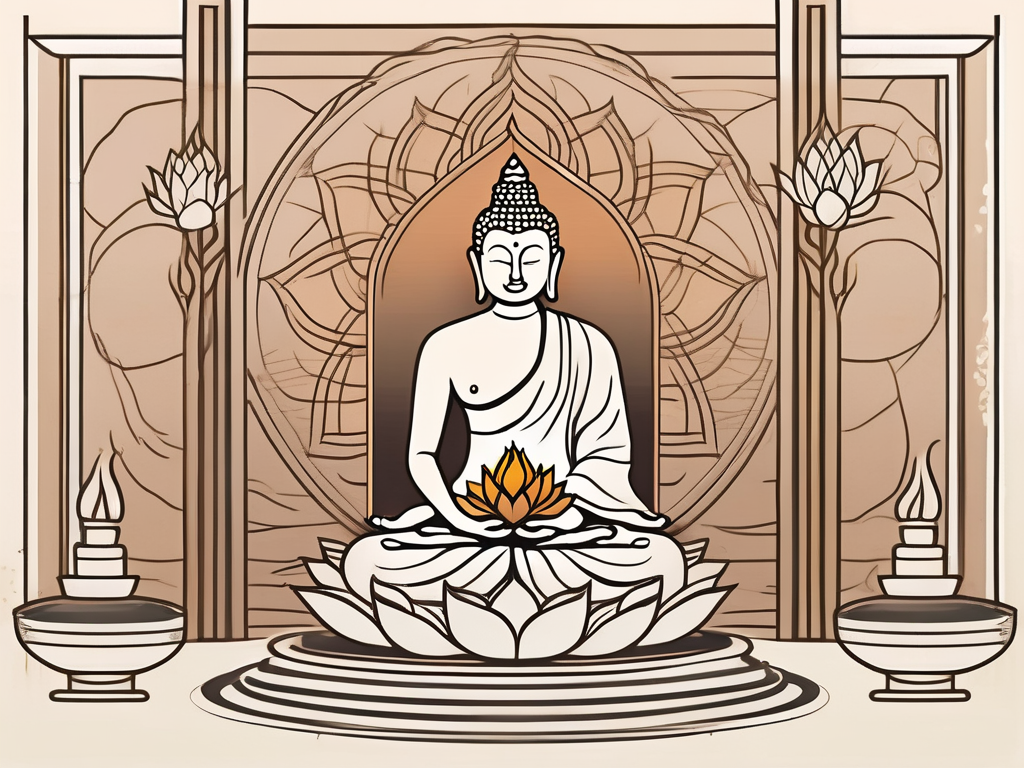Buddhism, with its rich history and deep philosophy, encompasses a wide range of beliefs and practices. One fascinating aspect of Buddhist teachings is its approach to sexuality. In this article, we will delve into the foundations of Buddhism, explore its perspectives on desire and sexual misconduct, examine the role of women and LGBTQ+ individuals in Buddhism, and discuss contemporary views on this topic.
The Foundations of Buddhism
Before delving into Buddhist beliefs on sexuality, it is essential to understand the foundational principles of this ancient tradition. Buddhism is built upon the Four Noble Truths and the Eightfold Path.
The Four Noble Truths
The Four Noble Truths serve as the core teachings of Buddhism. They encompass the truth of suffering, the origin of suffering, the cessation of suffering, and the path to the cessation of suffering. Buddhism posits that suffering arises from desire and attachment.
Let’s explore each of the Four Noble Truths in more detail:
1. The Truth of Suffering: Buddhism acknowledges that suffering is an inherent part of human existence. It encompasses physical pain, emotional distress, and the dissatisfaction that arises from unfulfilled desires.
2. The Origin of Suffering: According to Buddhism, the root cause of suffering is craving or attachment. It is the insatiable desire for pleasure, material possessions, and even the desire for existence itself that leads to suffering.
3. The Cessation of Suffering: The good news is that Buddhism offers a path to the cessation of suffering. By eliminating desire and attachment, individuals can attain a state of liberation known as Nirvana. Nirvana is a state of complete freedom from suffering and the cycle of birth and death.
4. The Path to the Cessation of Suffering: This path is known as the Noble Eightfold Path, which we will explore in the next section.
The Eightfold Path
The Eightfold Path outlines the steps that lead to enlightenment or liberation from suffering. It is a practical guide for living a meaningful and ethical life. Let’s take a closer look at each aspect of the Eightfold Path:
1. Right View: This refers to understanding and accepting the Four Noble Truths, as well as the interconnectedness of all things.
2. Right Intention: It involves cultivating wholesome intentions, such as renouncing harmful actions, practicing compassion, and developing loving-kindness.
3. Right Speech: This aspect emphasizes the importance of truthful, kind, and non-harmful communication.
4. Right Action: It involves acting in ways that are morally upright and beneficial to oneself and others. This includes refraining from harming living beings, stealing, and engaging in sexual misconduct.
5. Right Livelihood: This aspect encourages individuals to earn a living in a way that is ethical and does not cause harm to others.
6. Right Effort: It involves making a continuous effort to cultivate positive qualities, abandon negative habits, and maintain a balanced state of mind.
7. Right Mindfulness: This aspect entails being fully present and aware of one’s thoughts, feelings, and actions in the present moment.
8. Right Concentration: It refers to the practice of developing deep concentration and focus through meditation, leading to a calm and clear mind.
By following the Eightfold Path, individuals can gradually free themselves from suffering and attain enlightenment.
Buddhism and Sexuality: An Overview
When it comes to Buddhism and sexuality, it is important to understand that Buddhism does not hold a monolithic view on this topic. Different Buddhist traditions and interpretations may vary in their perspectives. However, there are some common threads that run through most Buddhist teachings.
Buddhism, as a philosophy and way of life, places great emphasis on understanding and transcending the human experience of suffering. It recognizes that desire, including sexual desire, is a fundamental cause of suffering. In Buddhism, desire is seen as a never-ending cycle that perpetuates attachment and ultimately leads to dissatisfaction and unhappiness.
However, Buddhism does not advocate for the complete suppression or denial of desire. Instead, it encourages practitioners to cultivate non-attachment and mindfulness in their approach to desire. By developing awareness and understanding of the impermanent nature of desires, individuals can gradually transcend them and find liberation from suffering.
The Role of Desire in Buddhism
Desire, according to Buddhism, is seen as a fundamental cause of suffering. Buddhism encourages practitioners to cultivate non-attachment and mindfulness to transcend desire and ultimately find liberation from suffering.
One of the key teachings in Buddhism is the concept of the Four Noble Truths, which outline the nature of suffering and the path to its cessation. The second noble truth states that the cause of suffering is craving or desire. This includes not only desires for material possessions and worldly achievements but also desires of a sexual nature.
However, it is important to note that Buddhism does not view desire as inherently evil or sinful. Rather, it is the attachment and clinging to desires that lead to suffering. By recognizing the impermanence and unsatisfactory nature of desires, individuals can cultivate a sense of detachment and freedom.
The Concept of Sexual Misconduct
Buddhism places emphasis on ethical conduct, and this extends to sexuality as well. The concept of sexual misconduct is an important part of Buddhist teachings. It involves refraining from actions that cause harm, exploitation, or betrayal in sexual relationships.
In Buddhist teachings, sexual misconduct is seen as a violation of the ethical principles of non-harming (ahimsa) and right action (samma kammanta). It encompasses a wide range of behaviors, including adultery, rape, sexual harassment, and any form of sexual exploitation or abuse.
Furthermore, Buddhism encourages individuals to approach sexual relationships with mindfulness and compassion. It emphasizes the importance of mutual consent, respect, and the well-being of both oneself and one’s partner. This means being mindful of the intentions and consequences of one’s actions, and ensuring that sexual relationships are based on trust, honesty, and genuine care for one another.
It is worth noting that Buddhist teachings on sexuality are not meant to impose strict moral codes or judgments on individuals. Instead, they serve as guidelines for leading a wholesome and ethical life, with the aim of reducing suffering and promoting well-being for oneself and others.
The Third Precept: Sexual Misconduct
One specific aspect of sexual ethics in Buddhism is the Third Precept, which addresses sexual misconduct. Sexual misconduct is defined as engaging in sexual activities that harm oneself or others.
In order to fully understand the implications of the Third Precept, it is important to explore the various interpretations that exist within different Buddhist traditions. These interpretations may vary, leading to diverse perspectives on what constitutes sexual misconduct.
Interpretations of the Third Precept
Interpretations of the Third Precept may vary among different Buddhist traditions. Some interpret it strictly, advocating for celibacy or monogamy within a heterosexual marriage. This approach emphasizes the importance of sexual restraint and the commitment to a single partner.
On the other hand, there are those who take a more flexible approach to interpreting the Third Precept. They focus on concepts such as consent, honesty, and the absence of harm in sexual relationships. This perspective recognizes the importance of mutual respect and understanding between sexual partners.
Furthermore, some interpretations of the Third Precept extend beyond the traditional boundaries of monogamous relationships. These interpretations acknowledge the existence of diverse sexual orientations and relationships, emphasizing the need for ethical conduct and the avoidance of harm in all sexual encounters.
The Third Precept and Monastic Life
For monastic practitioners, the Third Precept often translates into celibacy. Monastics dedicate themselves to spiritual practice and renounce sexual relationships to deepen their spiritual journey. By abstaining from sexual activities, they aim to detach themselves from worldly desires and attachments.
Celibacy allows monastics to focus their energy on their spiritual transformation. By redirecting their sexual energy towards meditation and contemplation, they strive to cultivate inner peace and wisdom. This commitment to celibacy is seen as a way to transcend the physical realm and attain spiritual liberation.
Within monastic communities, the Third Precept is considered a fundamental aspect of the monastic code of conduct. It serves as a reminder of the importance of self-discipline and the renunciation of sensual pleasures. Monastics view celibacy as a means to attain spiritual purity and to fully dedicate themselves to the path of enlightenment.
It is worth noting that the practice of celibacy is not limited to monastic life. Lay Buddhists also have the option to embrace celibacy as a personal choice in their spiritual journey. By voluntarily abstaining from sexual activities, lay practitioners seek to cultivate mindfulness, discipline, and a deeper connection with their spiritual aspirations.
In conclusion, the Third Precept in Buddhism holds significant importance in guiding ethical conduct regarding sexual relationships. Its interpretations may vary, but the underlying principles of consent, honesty, and the absence of harm remain central. Whether through celibacy or the practice of ethical sexual relationships, the Third Precept serves as a reminder of the importance of cultivating compassion, respect, and mindfulness in all aspects of life.
Buddhism, Sexuality, and Gender
It is essential to explore the role of women in Buddhism, as well as the perspectives on gender and sexuality within the Buddhist tradition.
Buddhism, with its rich history and diverse traditions, has seen the active participation of women throughout the ages. From the time of the Buddha, women have been an integral part of the Buddhist community, contributing to its growth and development. The presence of nuns, known as bhikkhunis, has been documented since the early days of Buddhism. These dedicated women renounced worldly life to pursue spiritual practice, seeking liberation from suffering.
However, the role of women in Buddhism has not been without its challenges. In some traditions, women have faced limitations and inequalities, with their opportunities for advancement curtailed. This has led to discussions and debates within the Buddhist community about gender equality and the need to address these issues. Efforts are being made to promote inclusivity and provide equal opportunities for women to participate fully in all aspects of Buddhist practice.
The Role of Women in Buddhism
Throughout history, women have played significant roles in Buddhism. From the time of the Buddha, there have been nuns who dedicated themselves to spiritual practice. However, women in Buddhism have faced challenges and inequalities, with some traditions limiting their roles and opportunities for advancement.
Despite these challenges, women have made valuable contributions to the Buddhist tradition. They have served as teachers, scholars, and leaders, guiding both men and women on the path to enlightenment. Their wisdom and insights have enriched the understanding of Buddhist teachings and inspired countless individuals to embark on their own spiritual journeys.
Today, there are numerous organizations and initiatives that aim to empower women in Buddhism. These efforts focus on providing education, training, and support to women practitioners, allowing them to fully express their potential and contribute to the growth and development of Buddhism.
Buddhism and LGBTQ+ Perspectives
When it comes to LGBTQ+ perspectives, Buddhism offers varying viewpoints. While some traditions may hold conservative views, others are more inclusive and accepting. Contemporary Buddhist communities are engaged in dialogue, striving to create safe and inclusive spaces for LGBTQ+ individuals.
In recent years, there has been a growing recognition within the Buddhist community of the need to address issues related to gender and sexuality. Buddhist scholars and practitioners are exploring the teachings and scriptures to gain a deeper understanding of how Buddhism can be inclusive and supportive of LGBTQ+ individuals.
Some Buddhist organizations have taken steps to actively welcome and embrace LGBTQ+ individuals, creating spaces where they can practice and engage with the teachings without fear of discrimination or exclusion. These inclusive communities provide support, guidance, and acceptance, allowing LGBTQ+ individuals to explore their spirituality and find solace in the Buddhist path.
However, it is important to acknowledge that there are still challenges and debates within the Buddhist community regarding LGBTQ+ issues. Some traditional interpretations of Buddhist teachings may not fully align with contemporary understandings of gender and sexuality. This ongoing dialogue and exploration of Buddhist teachings are crucial in fostering understanding, compassion, and inclusivity for all individuals, regardless of their sexual orientation or gender identity.
Contemporary Views on Buddhism and Sexuality
In the modern world, Buddhism and sexuality are subjects of ongoing discussion and exploration. Let’s take a look at the views expressed by some prominent Buddhist leaders and how Buddhism has manifested itself in the West regarding sexuality.
Modern Buddhist Leaders on Sexuality
Modern Buddhist leaders are actively engaging in conversations about sexuality, seeking to make Buddhism more relevant to contemporary issues. They offer insights that blend ancient wisdom with modern perspectives, aiming to create a balanced approach that accommodates the complexities of human relationships.
Buddhism and Sexuality in the West
In the Western world, Buddhism has adapted and evolved, incorporating diverse cultural perspectives on sexuality. This has led to the emergence of engaged Buddhism, which emphasizes social justice, compassion, and inclusivity. Western Buddhists are actively exploring the intersection of Buddhism and sexuality, paving the way for progressive ideas and interpretations.
Conclusion
Understanding Buddhist beliefs on sexuality requires a nuanced exploration of the foundations of Buddhism, the concept of sexual misconduct, the role of women and LGBTQ+ individuals in Buddhism, and the contemporary views on this topic. Buddhism offers a rich tapestry of ideas and perspectives, encouraging practitioners to navigate desire, uphold ethical conduct, and cultivate compassion in their relationships.












